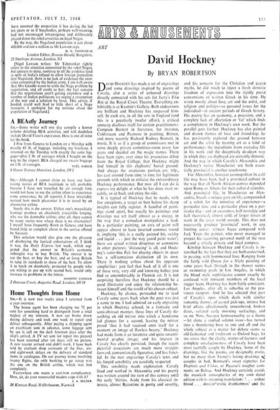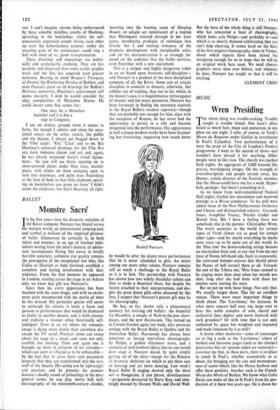David Hockney
&A"2 LTIUS11HLIs
ART
By BRYAN ROBERTSON
DAVID HockNEY has made a set of engravings and some drawings inspired by poems of Cavafy, also a series of coloured drawings directly connected with his sets for Jarry's Ubu Roi at the Royal Court Theatre. Everything ex- hibitable is at Kasmin's Gallery. Both endeavours are brilliant and Hockney has surpassed him- self. In each era, in all the arts in England (and this is a peculiarly insular affair), a critical amnesty discloses itself. for certain practitioners: Compton Burnett in literature, for instance, Coldstream and Pasmore in painting, Britten, and recently cently Richard Rodney Bennett, in music. It is as if a group of commissars met in some deeply private committee-room every few years and decided on the magic names. There have been signs, ever since his precocious debut from the Royal College, that Hockney might find himself in this elephants' burial ground. And always the suspicious puritan, yrs. trly., has cast around from time to time for legitimate grounds with which to criticise the extraordinary Hockney performance. But now all I can do is express my delight at what he has done most re- cently, so sit back and enjoy the ride. It is typical of Hockney that he needs, with few exceptions, a target or butt before his sharp insights can fully register. A handful of paint- ings stand apart, but usually his paintings and drawings use art itself almost as a stooge, in the way that a comedian manipulates a feed. In a particular painting, an area of paint will appear almost to have inverted commas round it, implying 'this is a really painted bit, swishy and liquid . . . just the way you'd paint water'; there are actual written directives or comments in other pictures; 'distancing' is all, and Hock- ney's razor-fine flair for placing objects in space has a self-conscious distinction all its own. There is nothing artless about his apparent simplicities: you feel that back of it all is one of those very, very old and knowing babies you find so uncomfortably in Flemish art. It is not surprising therefore that Hockney should be a good illustrator and enjoy the relationship be- tween himself and the world of his chosen subject. Hockney, by chance, persuaded me to read Cavafy some years back when the poet was just a name to me. I had admired an early engraving in which Hockney echoed, in a fantastic and semi-abstract manner, those lines of Cavafy de- scribing an old mirror into which a handsome lad glances for a second, leaving the mirror proud 'that it had received unto itself for a moment an image of flawless beauty.' Hockney had made from it an inventive and quite unsenti- mental graphic image; and his interest in Cavafy has clearly persisted, though the recent pictorial evocations are much more straight- forward, conventionally figurative, and less fanci- ful. In the new engravings Cavafy's texts and his limpid sensibility are carefully respected. This sensibility needs exploration. Cavafy lived and worked in Alexandria and his poetry was written around the turn of this century until the early 'thirties. Aside from his classical in- terests, almost Byzantine in purity and severity, and his concern for the Christian and pagan myths, he did much to inject a fresh demotic freedom of expression into the rigidly purist conventions of written Greek in his time. He wrote mostly aboutlove, art and the artist, and religion and politics—as personal issues for the ancient periods of Greek individual—in nc history. His poetry has an economy, a precision, and a complete lack of affectation or 'fat' which finds a complement in Hockney's own work. But the parallel goes further. Hockney has also painted themes of lo and drawn theve and friendship; he ex has persistently explored the ground between art and the artist by treating art as a kind of performance; the ingredients from everyday life in his work and the deceptively deadpan way in which they are deployed are certainly demotic. And the way in which Cavafy's Alexandria and Hockney's native Manchester are both essen- tially provincial is another touchstone. For Alexandria, however cosmopolitan its café life may have been, had a provincial culture in the way that all North African centres depended upon Rome or Athens for their cultural stimulus. And provincial life, in Manchester or Alex- andria, breeds a unique gaze on life, compounded of a relish for the minutiae of experience—a and a particular place on a par-
ticular time
ticular day--and an awareness, half nostalgic and half theoretical, almost cold, of larger forces at work in the great world outside. This does not necessarily produce 'provincial' work, in any limiting sense : witness Joyce compared with Jack Yeats the painter, who never managed to project his recurring personal motif of the rose beyond a strictly private and local compass. Kinship between Hockney and Cavafy is in- tensified by the fact that they are both concerned, in passing, with homosexual love. Ranging from the fairly wild Queen for a Night painting of some years back through to the shower scenes or swimming pools in Los Angeles, in which the blond male sophisticates cannot exactly be confused with innocent members of the local rugger team, Hockney has been fairly consistent. Los Angeles, after all, is suburbia or the pro- vinces rampant. And he has selected that part of Cavafy's opus which deals with similar romantic themes, of casual pick-ups, intense but brief affairs affectionately remembered, broken dates, satiated early morning surfacings, and so on. Now, because homosexuality as a theme —let alone a studied solemn issue—has turned into a thundering bore to one and all and the whole subject as a matter for debate seems as old-fashioned and irrelevant as Oxford bags, let me stress that the clarity, matter-of-factness and complete unsalaciousness of Cavafy have been most tactfully caught by Hockney. Some of the drawings, like the poems, are designedly erotic, but no more than Turner's loving drawings < couples in bed, Bonnard's sweet vignettes for Daphnis and Chloe, or Picasso's tougher com- ments on Balzac. And Hockney certainly avoids the mawkish atmospherics of my own dated edition with its steaming translation: `. . . ardent blood . . . deviate" erotic drunkenness' and the rest. I can't imagine anyone being embarrassed by these amiably mindless youths of Hockney, sprawling in the bedclothes; whilst the self- consciously engrossed couple dating each other up over the haberdashery counter, under the unseeing gaze of the storekeeper, could ring a bell with most of us, given transplantation.
These drawings and engravings are techni- cally and aesthetically stunning. They are less scratchy and dispersed than some earlier graphic work and the line has acquired even greater economy. Bearing in mind Braque's Theogony of Hesiod, the Wuthering Heights of Balthus, and even Picasso's great set of drawings for Buffon's Histoires naturelles, Hockney's achievement still seems masterly. I wish he would consider the edgy complexities of Marianne Moore. He could invent some fine scenes for: One may be a blameless bachelor and it is but a step to Congreve.
I am on shakier ground when it comes to Jarry, for though I admire and enjoy his occa- sional essays on the artist, society, the public and the theatre, I always get bogged down in the `Ubu' cycle: `It oi,"Cocu' and so on. But Hockney's coloured drawings for the Ubu Roi sets have immense- charm and wit and, again, he has clearly respected Jarry's visual injunc- tions: 'So you will see doors opening on to snow-covered plains under blue skies, mantel- pieces with clocks on them swinging open to turn into doorways, and palm trees flourishing at the foot of beds so that little elephants perch- ing on bookshelves can graze on them.' I didn't count the elephants, but that's Hockney all right.







































 Previous page
Previous page